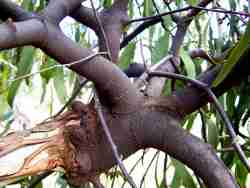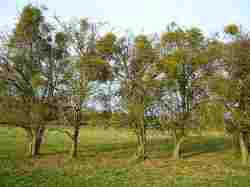
Mistletoe
Mistletoes grow on a wide range of host trees, some of which experience side effects including reduced growth, stunting, and loss of infested outer branches. A heavy infestation may also kill the host plant. Viscum album (European mistletoe) is the only species native to the British Isles and much of Europe. A separate species, Viscum cruciatum, occurs in Southwest Spain, Southern Portugal, and Morocco (North Africa).
Viscum album grows on about 200 tree and shrub species.
Eastern mistletoe, Phoradendron leucarpum, is native to North America. It belongs to a distinct genus of the family Santalaceae. The genus Viscum is not native to North America, but Viscum album has been introduced to California. European mistletoe has smooth-edged, oval, evergreen leaves borne in pairs along the woody stem, and waxy, white berries in clusters of two to six. Eastern mistletoe is similar but has shorter, broader leaves and longer clusters of 10 or more berries.
A mistletoe seed germinates on the branch of a host tree or shrub, and in its early stages of development it is independent of its host. It commonly has two or even four embryos, each producing its hypocotyl, that grows towards the bark of the host under the influence of light and gravity, and potentially each forming a mistletoe plant in a clump. Possibly as an adaptation to assist in guiding the process of growing away from the light, the adhesive on the seed tends to darken the bark. On having made contact with the bark, the hypocotyl, with only a tiny scrap of root tissue at its tip, penetrates it; a process which may take a year or more. In the meantime the plant is dependent on its own photosynthesis. After it reaches the host's conductive tissue can it begin to rely on the host for its needs. Later it forms the equivalent of a root (a haustorium) which penetrates the host tissue and takes water and nutrients from the host plant.
Most mistletoe seeds are spread by birds eating the seeds. Of the many bird species that feed on them, the mistle thrush is the best-known in Europe. Depending on the species of mistletoe and the species of bird, the seeds are regurgitated from the crop, excreted in its droppings, or stuck to the bill, from which the bird wipes it onto a suitable branch. The seeds are coated with a sticky material called viscin. When it touches a stem, it sticks. The viscin soon hardens and attaches the seed firmly to its future host, where it germinates and its haustorium penetrates the sound bark.
Biochemically, viscin is a complex adhesive mix containing cellulosic strands and mucopolysaccharides.
Once a mistletoe plant is established on its host, it usually is possible to save a valuable branch by careful pruning and removal of the wood invaded by the haustorium, if the infection is caught early enough.
Mistletoe plants are toxic though their effects are not usually fatal.Their effects include blurred vision, diarrhoea, nausea and vomiting. Toxins are more concentrated in the leaves and berries of the plant. Children are much more susceptible to the effects than adults. The European mistletoe (Viscum Album) is more toxic than the American mistletoe (Phoradendron serotinum).
In Norse Mythology, Loki tricked the blind god Hodur into murdering his own twin brother Balder with an arrow made of mistletoe wood, being the only plant to which Balder was vulnerable.
The county flower of Herefordshire is mistletoe, and every year, the UK town of Tenbury Wells holds a mistletoe festival and crowns a 'Mistletoe Queen'.
Mistletoe is also, apparently, one of the ingredients in Asterix's magic potion for beating up Ancient Britons.
About a fortnight ago I asked the following question on social media:
Which trees are the best hosts for mistletoe? I've seen mistletoe on apple, hawthorn, lime. Are there any others? Some of the limes near Tenbury (Worcs) have sixty or seventy lots growing on their branches.
There were some interesting responses, which I'm summarising below.
RC said that it occurs most frquently on apple, poplar or lime, but that our subspecies of mistletoe Viscum album ssp album has also been recorded on many dozens of other hosts, more than any other mistletoe species or subspecies. Some other subspecies of V album are restricted to fewer hosts or even to only one, but these sub-species don't occur in the British Isles. Amongst the more unusual hosts he has seen are silver birch, crack willow and hazel. The poplars it grows on include black poplar, Populus nigra, but it seems not the native black poplar subspecies, P nigra ssp betulifolia. It can therefore be an aid to ID of this rare and spectacular tree. It's seen more often on hybrid poplar, P x canadensis and reportedly also on Lombardy poplar, P nigra var italica.
BL in Northamptonshire reported that they are getting more mistletoe than before in the county and several populations are turning up in residential areas in Northampton as well as the urban parks there. Several host species are being used including False acacia, hawthorn and especially European lime. BL also reports that if you see mistletoe in an oak then that is unusual but not unknown; there are no records of mistletoe in oak that he knows of in Northants.
BB reports that he has it on a Rowan and that it grew on a plum (prunus).
Here are a couple of pictures, taken from the wikipedia article on mistletoe, reproduced under the terms of the Creative Commons Licence. Attribution: the first photo (mistletoe on Eucalyptus in Australia) is by Fir0002 and the second (mistletoe in the Wye Valley) is unattributed and public-domain.
Click on the thumbnails for more detail. I have reduced the resolution to limit the filesize to about 30kB.

